The Hyaluronic Viscosupplementation Market is estimated to be valued at USD 2.7 billion in 2025 and is projected to reach USD 4.3 billion by 2035, registering a compound annual growth rate (CAGR) of 4.9% over the forecast period.
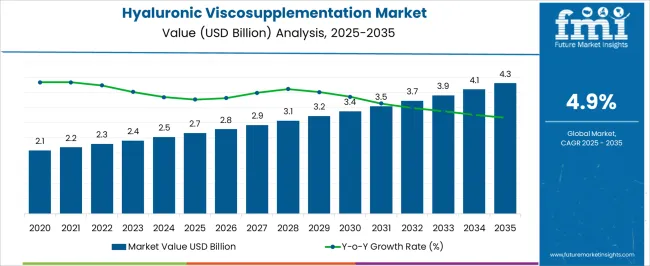
| Metric | Value |
|---|---|
| Hyaluronic Viscosupplementation Market Estimated Value in (2025 E) | USD 2.7 billion |
| Hyaluronic Viscosupplementation Market Forecast Value in (2035 F) | USD 4.3 billion |
| Forecast CAGR (2025 to 2035) | 4.9% |
The Hyaluronic Viscosupplementation market is experiencing significant growth, driven by the increasing prevalence of osteoarthritis and joint degeneration worldwide. Rising demand for minimally invasive treatments to relieve pain and improve joint mobility is supporting market expansion. Advanced hyaluronic acid formulations and single injection therapies have enhanced patient compliance and treatment outcomes by providing longer-lasting relief with fewer clinic visits.
Integration of high-quality biocompatible materials and improvements in molecular weight formulations has increased efficacy and safety, making these treatments preferred by orthopedic specialists. Growing awareness among patients and healthcare providers regarding non-surgical joint therapies is further accelerating adoption.
Research and development efforts focusing on enhanced viscosupplement properties, including cross-linked and high molecular weight hyaluronic acids, are enabling more effective lubrication and shock absorption in affected joints As healthcare providers continue to prioritize patient comfort and improved quality of life, and as healthcare infrastructure expands, the market is expected to witness sustained growth, with innovative products and targeted delivery systems creating opportunities across key geographies.
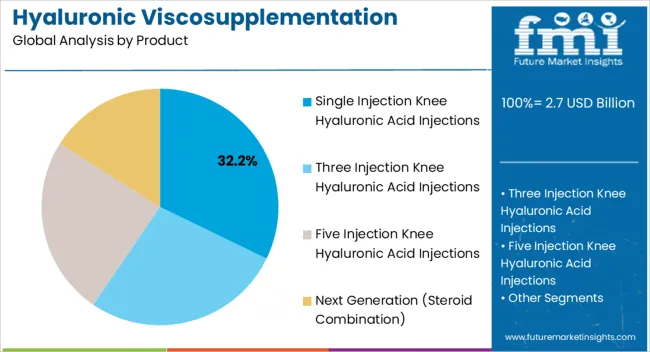
The single injection knee hyaluronic acid injections segment is projected to hold 32.2% of the market revenue in 2025, establishing it as the leading product category. Growth in this segment is being driven by the convenience and patient compliance associated with single-dose therapies, which reduce the frequency of clinical visits and provide extended relief compared to multi-injection regimens.
The ability to deliver high concentrations of hyaluronic acid in a single injection enhances lubrication and cushioning of the joint, improving mobility and reducing pain effectively. Orthopedic specialists prefer this product due to predictable therapeutic outcomes and improved patient adherence.
The increasing adoption of minimally invasive procedures in outpatient settings and enhanced physician confidence in the safety profile of single injection therapies further support growth With ongoing advancements in formulation and delivery technology, the single injection knee hyaluronic acid segment is expected to maintain its leading position, providing a combination of clinical efficacy, patient convenience, and cost-effectiveness that drives market preference.
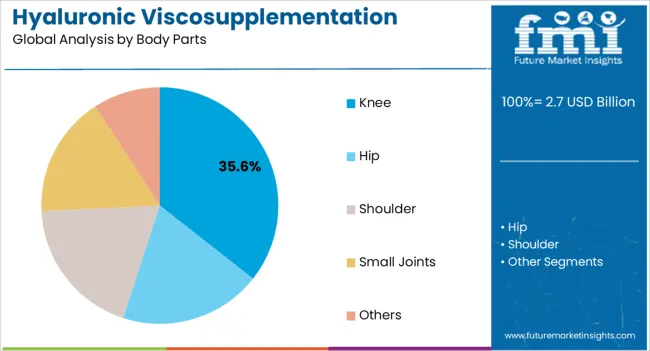
The knee segment is anticipated to account for 35.6% of the market revenue in 2025, making it the leading body part category. Growth is being driven by the high prevalence of knee osteoarthritis and joint-related disorders that affect mobility and quality of life. Knees are highly susceptible to wear and degeneration due to weight-bearing functions and repetitive mechanical stress, making them primary targets for hyaluronic viscosupplementation therapies.
Clinical outcomes have been improved through precise intra-articular injections, which deliver hyaluronic acid directly to affected areas, providing pain relief and enhanced joint lubrication. The focus on non-surgical and minimally invasive treatment options has increased patient preference for knee injections over other joint therapies.
Advancements in imaging guidance and injection techniques have further improved efficacy and safety As awareness of joint health and demand for functional mobility continue to rise, the knee segment is expected to remain the primary driver of revenue within the hyaluronic viscosupplementation market.
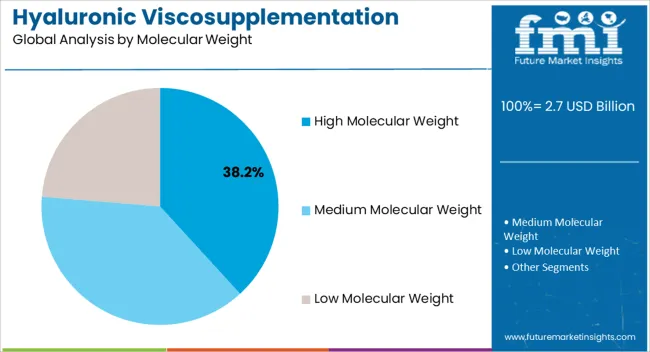
The high molecular weight segment is projected to hold 38.2% of the market revenue in 2025, establishing it as the leading molecular weight category. Its growth is being driven by superior viscoelastic properties that improve joint lubrication, shock absorption, and overall therapeutic outcomes. High molecular weight hyaluronic acids provide longer-lasting effects, reducing the need for repeated injections and improving patient satisfaction.
Enhanced clinical efficacy in terms of pain reduction and improved mobility has strengthened adoption among orthopedic specialists and healthcare providers. Research and development efforts have focused on optimizing molecular weight to balance viscosity, injectability, and bioavailability, enabling consistent treatment outcomes.
Patients increasingly prefer high molecular weight formulations due to extended relief and reduced treatment burden As minimally invasive therapies continue to gain popularity and clinical evidence supports their effectiveness, the high molecular weight segment is expected to maintain its leading position, driving overall growth in the hyaluronic viscosupplementation market.
The global market for hyaluronic viscosupplementation was around 24.4% of the overall USD 2.7 Billion of the global hyaluronic acid based products market in 2025.
Knee osteoarthritis is a chronic degenerative condition that affects the structure of the joints and causes inflammation, leading to joint discomfort and functional restrictions. Significant population globally suffers from osteoarthritis, a multifactorial origin joint disease, with high prevalence in adults.
Because of its low allergic reaction rate, simplicity of injection, speedy recovery, repeatability, and quick effects, hyaluronic acid filler has gained popularity. Hyaluronic acid injections into the joints are another common procedure, particularly for individuals with osteoarthritis of the knees.
In light of doctors' general reluctance to provide repeated injection of intra-articular corticosteroid injections, hyaluronic acid injection as a non-surgical therapeutic option have gained large popularity.
Owed to the above factors, the global market is projected to grow at CAGR of 5.2% in forecasted period.
Viscosupplementation offers a structural benefit in knee osteoarthritis treatment, with improved visual appearance and increased cartilage volume. One year after treatment, joint surface reconstitutes, with reduced loss of joint space. This results in a cost-effectiveness relationship and potential delay in total knee arthroplasty.
First-line therapy for OA focuses on joint preservation and alleviating symptoms. Intra-articular hyaluronic acid injections (IAHA) are a promising nonsurgical treatment, particularly for mild-to-moderate OA and severe OA with comorbidities.
IAHA, a nonsurgical treatment modality, has gained popularity in managing knee OA, despite the lack of established disease-modifying treatments. Surgical methods for total knee replacement (TKR) are successful, although they have a risk-benefit ratio. Although intra-articular hyaluronic acid (IAHA) therapy or viscosupplementation have grown in recognition, there isn't enough solid research to back up their efficacy and safety.
IAHA gives patients with knee OA a little clinical benefit without safety issues, whereas viscosupplementation has a substantial benefit-to-risk ratio and speeds up TKR. IAHA improves knee OA by allowing lubrication, shock absorption, and re-establishing joint homeostasis through induction of endogenous HA production. It reduces analgesic usage to half and leads to a 40-month improvement in pain and joint function.
Price and synthesis of HA products vary, with some made synthetically through biotechnology, while others are derived from animals. These differences impact the healthcare system's economic impact. Stabilized hyaluronic acid, a new generation of HA preparations, offers a long half-life and high density, reducing injections and puncture risk in osteoarthritis treatment.
Viscosupplementation saves money in the long run by postponing surgery for severe pain, allowing therapeutic prosthesis installation, and enhancing the patient's quality of life.
National and international guidelines discourage intra-articular hyaluronic acid derivatives. In countries like England, viscosupplementation is given low NHS funding priority due to the Institute's recommendation. HA injections in the knees are frequently associated with poor tolerance and failure rates, with anteromedial injections exhibiting up to 30% local reaction rates.
The efficacy of viscosupplementation is being questioned, which might be attributed to improper usage or a poorly fitted patient OA profile. A qualified expert is required for HA injection, which is difficult in a non-swollen joint. Some of research published claim hyaluronic viscosupplementation to be ineffective in osteoarthritis, these factors act as restraints for demand of hyaluronic viscosupplements.
The USA occupies 50.0% of market share in 2025 globally. As per British Medical Journal (BMJ-Clinical research ed.) 2025, Medicare, and commercial insurance companies increased viscosupplementation coverage, with hyaluronic acid injections becoming first-line treatment for knee osteoarthritis.
This makes USA prominent market for hyaluronic viscosupplementation in North America.
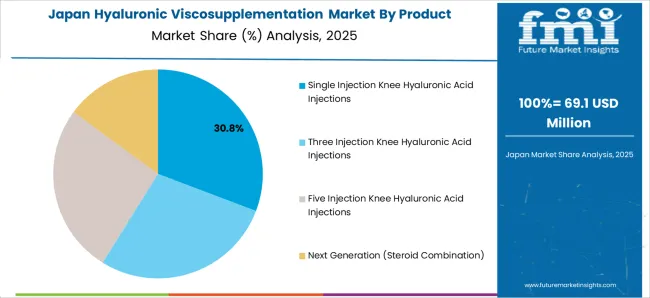
Japan expenditure on hyaluronic viscosupplementation in 2025 was USD 2.7 Million.
OA education, weight management, self-management, and exercise are crucial for improving knee OA. However, few patients are willing to undergo surgery, especially in Japan. Surgeons may delay surgery for elderly or unwilling patients, and there is a disconnect between physicians and patients. Improved communication between physicians and patients is needed to better understand the potential benefits of surgery. This makes Japan a Lucrative market for hyaluronic viscosupplementation market.
In 2025, the China held a significant share in the East Asia market and contributed around USD 157.8 Million. China faces a significant burden of knee osteoarthritis, affecting 250 million people worldwide and causing disability.
With a large population, more patients may require rehabilitation treatment and replacement, posing a significant public health burden for China. This makes China a large market for hyaluronic viscosupplements.
By product, three injection knee hyaluronic acid injections held 49.1% market share in world in 2025.
These injections were generally safe and showed a significant improvement in pain only at 6 months. However, more than or 5 injections were associated with a higher risk of treatment-related adverse events. Thus, demand for three injection knee hyaluronic acid injections are predicted to expand rapidly between 2025 and 2035.
Why Molecular Weight is Preferred Prominently in Hyaluronic Viscosupplementation?
The market value of high molecular weight hyaluronic viscosupplementation is USD 2.7 Billion, representing a sizable 68.8% market share in 2025. Hyaluronic acid is a high molecular weight polysaccharide used in various applications. The topic of molecular weight and hyaluronic acid's protective physicochemical functions remains controversial.
Most studies show a direct correlation between molecular weight and its effects on synoviocytes. However, some authors believe in vivo effects may differ due to excessive molecular size, preventing its ability to move from intra-articular to intercellular environments. The relationship between molecular weight and analgesia is evident in both in vitro and in vivo results, with products with molecular weight between 0.5 and 1 x 106 Da showing the best in vivo effects. Hence, high molecular weight hyaluronic viscosupplementation is preferred prominently.
By body part, the knee accounted for the prominent share in the global hyaluronic viscosupplementation market, with a revenue share of 85.2% in 2025. This segment is expected to continue holding prominent market share by the end of forecast period.
Viscosupplementation is an outpatient procedure for knees, with application method well established. Quantity and frequency depend on product characteristics and professional experience. Viscosupplementation in knee osteoarthritis has been observed to increase cartilage volume, with biopsies showing better matrix quality and increased chondrocyte density. This treatment may present a cost-effectiveness relationship, potentially reducing joint space loss.
The ambulatory surgical centers have a considerable presence in the hyaluronic viscosupplementation market, accounting for 31.7% value share in 2025, and exhibiting a high CAGR of 5.5% over the forecast period.
Pseudosepsis cases submitted to the FDA, including those involving injections of non-cross-linked hyaluronic acid, necessitate rehabilitative therapy and anti-inflammatory medications. Ambulatory surgical centers offer expert guidance and 24/7 care, benefiting end users in the hyaluronic viscosupplementation market.

Collaborations and collaborations among healthcare providers, research institutions, and technology businesses can encourage innovation and hasten hyaluronic viscosupplementation. Collaboration in research, development, and commercialization can lead to market expansion and the creation of new applications. Numerous large firms compete in the field of hyaluronic viscosupplementation. Among the well-known players in this field are:
Similarly, recent developments related to the company’s manufacturing the hyaluronic viscosupplementation injections have been tracked by the team at Future Market Insights, which are available in the full report.
| Attributes | Details |
|---|---|
| Forecast Period | 2025 to 2035 |
| Historical Data Available for | 2012 to 2025 |
| Market Analysis | USD Million for Value, Units for Volume |
| Key Regions Covered | North America; Latin America; Europe; South Asia; East Asia; Oceania; Middle East and Africa (MEA) |
| Key Countries Covered | USA, Canada, Brazil, Mexico, Argentina, Germany, Italy, France, United Kingdom, Spain, BENELUX, Russia, Nordics, China, Japan, South Korea, India, Indonesia, Thailand, Philippines, Malaysia, Australia, New Zealand, GCC countries, Türkiye, Israel, Northern Africa and South Africa. |
| Key Market Segments Covered | Product, Body Part, Molecular Weight, Indication, End User, and Region |
| Key Companies Profiled | Anika Therapeutics Inc.; Zimmer Biomet; Sanofi S.A.; LG Chem; Chugai Pharmaceutical Co., Ltd.; Meiji Seika Pharma co. ltd; Ferring B.V.; Hanmi Pharm.Co.,Ltd.; Anika Therapeutics, Inc.; Fidia Farmaceutici s.p.a.; Bioventus LLC; OrthogenRx; Seikagaku Corporation; Bioiberica S.A.U.; APTISSEN; Hangzhou Singclean Medical Products Co.,Ltd; Maxigen Biotech Inc.; TRB Chemedica International SA; Yuria-Pharm LLC; Haohai Biological Technology; Chroma Pharma |
| Report Coverage | Market Forecast, Competition Intelligence, DROT Analysis, Market Dynamics and Challenges, Strategic Growth Initiatives |
| Pricing | Available upon Request |
The global hyaluronic viscosupplementation market is estimated to be valued at USD 2.7 billion in 2025.
The market size for the hyaluronic viscosupplementation market is projected to reach USD 4.3 billion by 2035.
The hyaluronic viscosupplementation market is expected to grow at a 4.9% CAGR between 2025 and 2035.
The key product types in hyaluronic viscosupplementation market are single injection knee hyaluronic acid injections, three injection knee hyaluronic acid injections, five injection knee hyaluronic acid injections and next generation (steroid combination).
In terms of body parts, knee segment to command 35.6% share in the hyaluronic viscosupplementation market in 2025.






Full Research Suite comprises of:
Market outlook & trends analysis
Interviews & case studies
Strategic recommendations
Vendor profiles & capabilities analysis
5-year forecasts
8 regions and 60+ country-level data splits
Market segment data splits
12 months of continuous data updates
DELIVERED AS:
PDF EXCEL ONLINE
Hyaluronic Acid Boosters Market Analysis - Size and Share Forecast Outlook 2025 to 2035
Hyaluronic Acid Products Market Insights - Demand, Growth & Forecast 2025 to 2035
Hyaluronic Acid Supplement Market Product, Type, Application, Distribution Channel and Others Through 2035
Hyaluronic Acid Personal Care Products Market Overview - Growth & Forecast 2025 to 2035
Hyaluronic Acid Market Growth – Trends & Forecast 2024-2034
Non-Hyaluronic Acid Dermal Filler Market Size and Share Forecast Outlook 2025 to 2035
USA Hyaluronic Acid Products Market Insights – Growth, Demand & Forecast 2025-2035
Knee Hyaluronic Acid Injections Market Analysis - Size, Share, and Forecast Outlook 2025 to 2035
Vegan Hyaluronic Acid Market Size and Share Forecast Outlook 2025 to 2035
Japan Hyaluronic Acid Products Market Analysis – Growth, Applications & Outlook 2025-2035
Brazil Hyaluronic Acid Products Market Outlook – Share, Growth & Forecast 2025-2035
Germany Hyaluronic Acid Products Market Trends – Size, Share & Growth 2025-2035
South Korea Hyaluronic Acid Products Market Growth – Trends, Demand & Innovations 2025-2035
Plant-Derived Hyaluronic Acid Alternatives Market Analysis - Size, Share, and Forecast Outlook 2025 to 2035
Viscosupplementation Market Analysis - Size, Share, and Forecast Outlook 2025 to 2035
Viscosupplementation Industry Analysis in Europe - Size, Share & Forecast 2025 to 2035
Russia Viscosupplementation Market Analysis – Growth, Applications & Outlook 2025–2035

Thank you!
You will receive an email from our Business Development Manager. Please be sure to check your SPAM/JUNK folder too.
Chat With
MaRIA